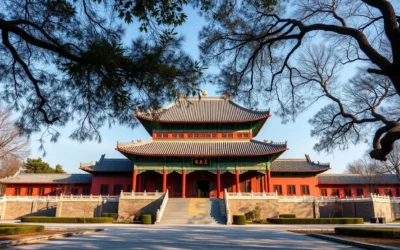✓ Accommodations✓ Flights✓ Rental Cars
China is home to a fascinating array of languages, each reflecting its unique cultural heritage. At the heart of this diversity is Mandarin, the official language spoken by over 70% of the population. This makes it the most widely used language in the country and a cornerstone of communication.
Beyond Mandarin, there are numerous dialects that add to the linguistic richness. For example, Cantonese, with its six tones, is prominent in southern regions. Other dialects like Wu and Min are spoken by millions, showcasing the depth of China’s language traditions.
Understanding this linguistic landscape offers insight into China’s cultural identity. Whether you’re exploring the history of the Chinese language or its modern-day usage, the variety of dialects tells a story of unity and diversity.
Overview of China’s Linguistic Diversity
From bustling cities to rural villages, dialects shape daily communication. This region is home to over 300 living languages, each with its unique charm. Mandarin leads the way, spoken by over 900 million people, making it the most widely used language.

Understanding the Various Language Families
Languages here fall into distinct families, each with its own history and evolution. Mandarin, part of the Sino-Tibetan family, dominates the linguistic scene. Other families include Wu, Min, and Cantonese, each spoken by millions.
For example, Wu, also known as Shanghainese, is used by around 80 million people. Similarly, Cantonese, with its nine tones, is spoken by over 70 million individuals. These dialects highlight the rich linguistic heritage of the region.
Geographic and Demographic Insights
The distribution of languages varies across the country. Mandarin is prevalent in the north, while southern regions favor dialects like Cantonese and Min. This geographic divide reflects centuries of cultural and historical influences.
Demographically, over 80% of the population speaks Mandarin and its varieties. Minority languages, such as Hakka and Gan, are also significant, adding to the region’s linguistic mosaic.
Understanding this diversity offers a glimpse into the cultural fabric of the area. Whether you’re exploring the history of these languages or their modern-day usage, the variety of dialects tells a story of unity and identity.
Historical and Cultural Influences on Language
Migration and dynastic changes have left a lasting impact on language forms. Over centuries, shifts in population and ruling powers have shaped the way people communicate. For example, the Jin dialect emerged in Shanxi and nearby regions due to historical migrations.

The use of writing, particularly Chinese characters, has also played a key role in standardizing language. These characters, with their rich history, have helped unify diverse dialects. Written traditions date back to the Shang Dynasty, showcasing the enduring influence of ancient practices.
Migration, Dynasties, and Linguistic Shifts
Historical events like the spread of the Han Dynasty led to the dominance of Mandarin. This dialect became the foundation for modern communication. Similarly, the Wu dialect flourished in Zhejiang and Shanghai due to regional cultural influences.
Migration patterns also contributed to linguistic diversity. For instance, the Hakka dialect spread across Guangdong, Fujian, and Taiwan as communities moved. These shifts highlight how history and culture shape language forms.
Written versus Spoken Traditions
Written Chinese, using characters, differs significantly from spoken dialects. While written forms remain consistent, spoken languages vary widely. This contrast reflects the balance between tradition and everyday communication.
For example, traditional characters are used in Taiwan, while simplified forms are standard in mainland regions. This duality showcases the adaptability of Chinese writing across different cultures.
Understanding these traditions offers insight into the evolution of language. Whether exploring ancient texts or modern speech, the interplay between written and spoken forms reveals a fascinating linguistic journey.
Anhui Province, China: Official and widely spoken languages
Language in this region reflects a blend of tradition and modern policies. Mandarin is the dominant language, spoken by over 1.1 billion people nationwide. In addition, dialects like Lower Yangtze Mandarin and Central Plains Mandarin are widely used here.
Regional policies have shaped how people communicate. The government aimed for 80% of citizens to speak Mandarin by 2020, a goal successfully achieved. This policy ensures unity while preserving local dialects.

Ethnic groups add unique flavors to the linguistic mosaic. The Han community makes up 99% of the population, while the Hui group contributes 0.6%. Each group brings its own linguistic traditions, enriching the region’s cultural fabric.
Understanding language here means exploring both policy and culture. For example, Gan and Wu dialects are spoken by millions, adding to the diversity. These languages highlight the balance between official mandates and local practices.
| Language | Speakers | Region |
|---|---|---|
| Mandarin | 1.1 billion | Nationwide |
| Gan | 22.6 million | Jiangxi and surrounding areas |
| Wu | 83 million | Eastern regions |
Every person here contributes to the vibrant linguistic tapestry. Whether through Mandarin or local dialects, language is a key part of daily life. This combination of tradition and policy makes the region’s linguistic landscape truly unique.
The Role of Dialects and Minority Languages
Dialects and minority languages play a vital role in shaping cultural identity across diverse communities. They are more than just variations of a spoken language; they are a reflection of history, tradition, and local pride. Understanding their significance helps you appreciate the richness of communication in different regions.

Defining Dialects Compared to Languages
What makes a dialect different from a full language? While languages are often distinct and mutually unintelligible, dialects are regional variations of a primary language. For example, Cantonese and Mandarin are both part of the Chinese dialect family but differ significantly in pronunciation and vocabulary.
In China, over 302 living languages exist, with dialects like Wu, Min, and Gan adding to the linguistic mosaic. These variations are not just accents but carry unique cultural nuances. For instance, Wu, spoken by 6.1% of the population, is prevalent in Shanghai and Zhejiang.
Impact on Local Culture and Community
Dialects are a key part of community identity. They connect people to their heritage and foster a sense of belonging. In regions like Hong Kong, Cantonese is not just a dialect spoken daily but a symbol of local pride.
Minority languages also play a crucial role. For example, Tibetan and Uyghur are spoken by ethnic groups, preserving their unique traditions. These languages are more than communication tools; they are a testament to cultural resilience.
| Dialect | Speakers | Region |
|---|---|---|
| Cantonese | 5.6% of population | Guangdong, Hong Kong |
| Wu | 6.1% of population | Shanghai, Zhejiang |
| Min | 6.2% of population | Fujian |
Every group contributes to the linguistic tapestry, ensuring that dialects and minority languages remain vibrant. Whether through daily conversation or cultural events, these languages continue to enrich communities. Their preservation is a testament to the enduring power of cultural identity.
Language Policy and Education in Mainland China
Educational reforms in China focus on balancing Mandarin promotion with minority language preservation. The government has prioritized Mandarin Chinese as the official language to unify communication across diverse regions. This policy ensures that over 80% of the population can communicate effectively, fostering national cohesion.
At the same time, efforts are made to preserve minority languages. For example, textbooks in Tibetan, Uyghur, and Mongolian are used in schools where these languages are spoken. This approach highlights the importance of cultural heritage in education.
Mandarin Promotion and Minority Education
Mandarin Chinese has been promoted nationwide since 1956, with Article 19 of the 1982 Constitution reinforcing its status. Schools in urban and rural areas now prioritize Mandarin instruction, ensuring students are prepared for modern communication.
However, minority languages face challenges. For instance, only 30 minority languages have written scripts, limiting their use in formal education. Despite this, initiatives like bilingual education aim to bridge the gap between Mandarin and local dialects.
Hong Kong serves as a unique example. While Mandarin is widely taught, Cantonese remains the primary language in schools and daily life. This balance reflects the region’s distinct cultural identity.
Understanding these policies helps you appreciate the complexity of China’s linguistic landscape. Whether through Mandarin or minority languages, education plays a key role in shaping cultural and national identity. For more insights, explore heritage languages in China.
Comparing Mandarin and Other Chinese Variants
The linguistic landscape of Chinese dialects offers a fascinating glimpse into the cultural and phonetic diversity of the region. While Mandarin dominates as the most commonly spoken language, other variants like Cantonese, Wu, and Min add unique flavors to the mix. Understanding these differences helps you appreciate the richness of Chinese culture and communication.
Phonetic, Grammatical, and Cultural Differences
Mandarin, with its four tones, is known for its simplicity in pronunciation. In contrast, Cantonese uses six tones, making it more complex for learners. Wu, or Shanghainese, takes it further with eight tones, showcasing the diversity in phonetic structures.
Grammatically, Mandarin serves as the standard, while dialects like Min and Hakka often retain older structures. For example, Min dialects preserve ancient vocabulary, offering a window into historical language forms.
Culturally, each variant reflects regional identity. Cantonese is a symbol of pride in Guangdong and Hong Kong, while Wu is deeply tied to Shanghai’s heritage. These dialects are more than just ways to communicate; they are a testament to local traditions.
Preserving Regional Identity and Heritage
Despite Mandarin’s dominance, efforts to preserve regional dialects are ongoing. For instance, Cantonese remains the primary language in Hong Kong’s schools and media. Similarly, Wu is actively promoted in Shanghai through cultural events and education.
Minority languages like Hakka and Gan also play a vital role. Spoken by millions, these dialects connect communities to their roots. Their preservation ensures that cultural diversity thrives alongside linguistic unity.
Understanding these variants helps you see how language shapes identity. Whether through daily conversation or cultural practices, dialects remain a cornerstone of regional heritage.
| Dialect | Tones | Speakers |
|---|---|---|
| Mandarin | 4 | 920 million |
| Cantonese | 6 | 86 million |
| Wu | 8 | 81 million |
Exploring these differences reveals the intricate balance between unity and diversity. For more insights, check out the varieties of Chinese.
Insights from China’s Writing Systems and Language Evolution
The evolution of Chinese writing systems reveals a fascinating journey of tradition meeting modernity. Over the years, these scripts have adapted to meet the needs of a changing world while preserving their cultural roots. This balance between old and new is a testament to the resilience of traditional Chinese characters.
Traditional Scripts and Modern Adaptations
Traditional Chinese characters have a history spanning thousands of years. From oracle bone inscriptions to the standardized forms of the Qin Dynasty, these scripts have evolved significantly. The mid-20th century saw the introduction of simplified characters, a pivotal year in making literacy more accessible.
Despite these changes, traditional Chinese scripts remain a vital part of cultural identity. In regions like Taiwan and Hong Kong, traditional characters are still widely used, connecting communities to their heritage. This duality showcases the adaptability of Chinese writing systems.
Key terms like “Literary Chinese” and “vernacular” highlight the diversity within written forms. These variations serve as bridges between dialects, ensuring that written communication remains consistent across regions. For more on this, explore the history of Written Chinese.
The interplay between tradition and innovation continues to shape Chinese writing. Whether through ancient texts or modern adaptations, these scripts reflect the enduring power of language to unite and inspire. Discover more about this linguistic diversity at The Languages of China.
Conclusion
The evolution of language china reflects a blend of history and modernity. Over the past century, simplified chinese has become a cornerstone of communication, bridging traditional roots with contemporary needs. This shift highlights how language adapts to global trends while preserving cultural identity.
Understanding this linguistic journey offers insight into the broader world of language evolution. From dialects to standardized forms, each change tells a story of unity and diversity. These developments remind us of the importance of language in shaping societies.
As you explore the richness of language china, you’ll see how it continues to evolve. Whether through education or daily use, it remains a vital part of cultural heritage. For more on this topic, visit major languages spoken in China.
The above is subject to change.
Check back often to TRAVEL.COM for the latest travel tips and deals.






